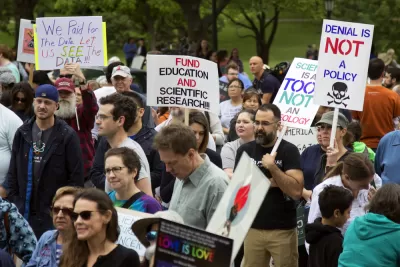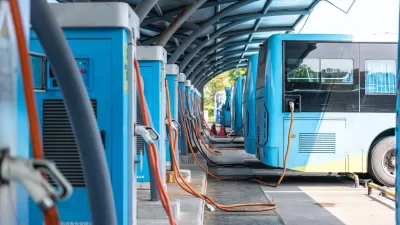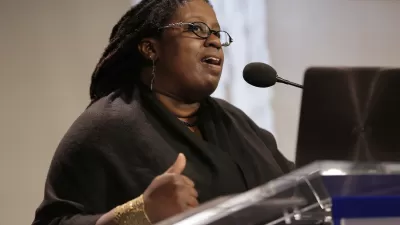Equity is hardly mentioned in most urban climate action plans, but a few cities, like Austin, Texas, are leading the charge to center in equity in both the process and content of climate planning.

Government has long been complicit in creating our nation's structural racism.
The nation was founded with slavery enforced by the state, and southern states continued to enforce Jim Crow even after Emancipation. In The Color of Law, Richard Rothstein definitively establishes that the U.S. government spread segregation to the North as the price of southern support for the New Deal. Federal and state governments colluded with developers and brokers to limit access of aspiring Black homeowners to white neighborhoods, resulting in government-created ghettoes. To this day, police violence is disproportionately directed against people of color, most recently in the George Floyd murder by Minneapolis police.
Along with residential exclusion and segregation environmental racism introduces another level of harm. Not surprisingly, the dirtiest of industrial facilities have been located in predominantly black and immigrant neighborhoods. These neighborhoods also have been deliberately exposed to sources of pollution—highways, incinerators, factories, oil-fired power plants, and more. Studying California, the Union of Concerned Scientists estimated that African Americans and Latinos are exposed to about 40 percent more particulate matter from cars, trucks, and buses than whites. The cumulative result is much higher levels of polluting particulate matter in Black neighborhoods and serious health consequences.
Further, the "Fourth National Climate Assessment," a congressionally mandated report on climate change and its impacts published by the U.S Global Change Research Program in 2018, warned that climate change disproportionately affects low-income communities and communities of color—and emphasized that government's need to work closely with those communities to develop solutions.
In this moment, it is time for every city to reframe urban climate action so that remedies for these wrongs inflicted on communities of color are at the forefront. Equity is hardly mentioned in most urban climate action plans, but that is changing. A few cities are leading the way on making it a focus—both in process and in content.
Austin is among a handful of cities exemplifying a broader and more representative participation process in developing and implementing climate action plans. Austin is a city marked by environmental racism stemming from its 1929 master plan that zoned industrial uses almost exclusively in minority neighborhoods.
Austin has been revising its Community Climate Plan during the pandemic. Zach Baumer, Austin's climate program manager, relates that racial equality and full participation representing the city’s diversity were key principles guiding the process and the content.
Before the planning process started, the city's Sustainability Office worked with a local human rights activist and community organizer, Dr. Tane Ward, to create a climate equity anti-racism training program that all staff and community activists involved in planning and outreach for the Community Climate Plan Process.
A key aspect of integrating equity into the climate planning process is effective outreach. Baumer worked with Austin’s chief equity officer for ongoing guidance on who to work with in the community and which groups were a must to have at the table during our process. Two years prior, the office hired an equity and inclusion fellow, Celine Rendon, for a summer internship (funded by the Urban Sustainability Directors Network). Rendon was hired back in the fall of 2019 as a community engagement specialist to draw on her skills, knowledge, and connections with local environmental and social justice groups. Having the trust of these groups, she set up meetings and made many connections with individuals to participate in the planning process. While finding community members willing to participate in the process took two weeks during the previous planning process (five years ago), this time the office allowed three months to recruit a more diverse set of participants.
The outreach effort achieved the city's goal for people of color to comprise more than half of the residents participating in the three-month planning process. A total of 140 people in five working groups were engaged in determining goals and strategies. Each committed to attending two two-hour planning meetings per month for six months. Participants were asked if they needed compensation for their time to participate in the process, and those who requested it were reimbursed $500 for the full commitment.
A separate group of 12 climate ambassadors was recruited to talk to people and gather feedback from residents on changes they wanted to see in their neighborhoods. These ambassadors were not climate activists, but were known in their communities through various community, arts, or other organizations. The ambassadors were creative in their outreach—holding house parties, going to church groups, and then switching to telephones and virtual venues once Covid-19 required social distancing. Ten individuals were paid $1,500 each for their outreach and reporting and two organizations that served as ambassadors received $3,000 each. The notes from interviews and interactions were recorded in reports, and then summarized into presentations to city staff and community members active in the planning process.
Assessing each goal of the plan was the next step of keeping racial equity front and center. On this front, Austin is one of several cities adapting an equity assessment tool developed by the Local and Regional Governmental Alliance on Race and Equity, a national network of local, state, and regional government working toward racial equity and increased opportunities and the Urban Sustainability Directors Network, which created the Equity Foundations Training completed by staff of the Austin Office of Sustainability. The equity tool allows cities to examine policies, plans, programs, and budgets to eliminate individual, institutional, and structural racism. The first question in the seven-step analysis of any goal of the plan: “Who benefits and who will be burdened?” The tool builds awareness to help city staff better recognize the unintended racial consequences of their work.
We see several factors related to Austin's success: staff who have been through equity and anti-racist training; a staff member dedicated to outreach and engagement; multiple ways of engaging residents of color; paying advisory committee members and offering childcare so participation can be sustained over time; and a process that ensures that equity is baked into all goals and strategies. Austin benefitted from networking with other USDN cities that were pioneers in this approach, in particular staff from Portland and Seattle.
Other cities could learn from Austin and the handful of other cities. But first we need a commitment to build climate justice into all climate action planning.

Alabama: Trump Terminates Settlements for Black Communities Harmed By Raw Sewage
Trump deemed the landmark civil rights agreement “illegal DEI and environmental justice policy.”

Study: Maui’s Plan to Convert Vacation Rentals to Long-Term Housing Could Cause Nearly $1 Billion Economic Loss
The plan would reduce visitor accommodation by 25% resulting in 1,900 jobs lost.

Planetizen Federal Action Tracker
A weekly monitor of how Trump’s orders and actions are impacting planners and planning in America.

Waymo Gets Permission to Map SF’s Market Street
If allowed to operate on the traffic-restricted street, Waymo’s autonomous taxis would have a leg up over ride-hailing competitors — and counter the city’s efforts to grow bike and pedestrian on the thoroughfare.

Parklet Symposium Highlights the Success of Shared Spaces
Parklets got a boost during the Covid-19 pandemic, when the concept was translated to outdoor dining programs that offered restaurants a lifeline during the shutdown.

Federal Homelessness Agency Places Entire Staff on Leave
The U.S. Interagency Council on Homelessness is the only federal agency dedicated to preventing and ending homelessness.
Urban Design for Planners 1: Software Tools
This six-course series explores essential urban design concepts using open source software and equips planners with the tools they need to participate fully in the urban design process.
Planning for Universal Design
Learn the tools for implementing Universal Design in planning regulations.
Caltrans
Smith Gee Studio
Institute for Housing and Urban Development Studies (IHS)
City of Grandview
Harvard GSD Executive Education
Toledo-Lucas County Plan Commissions
Salt Lake City
NYU Wagner Graduate School of Public Service






























